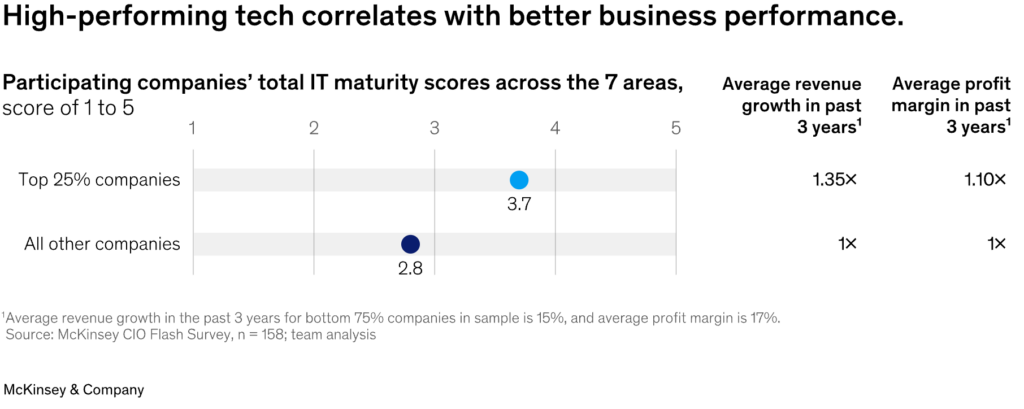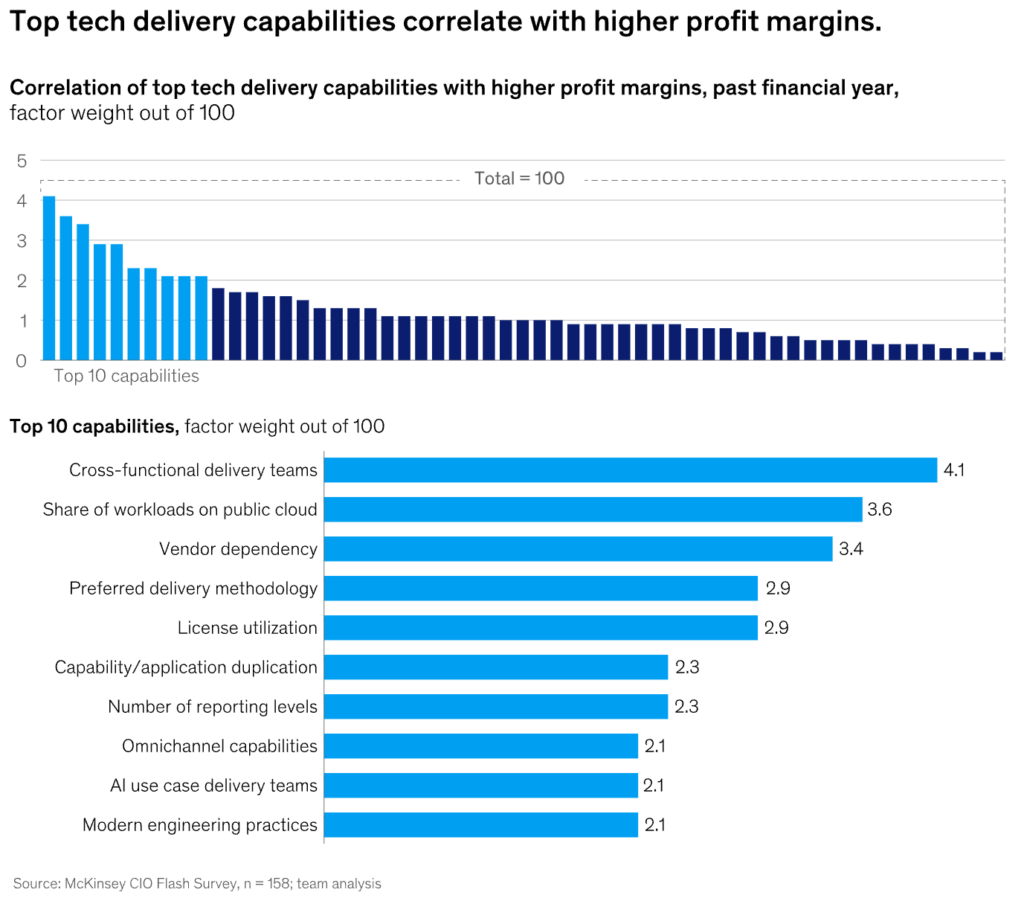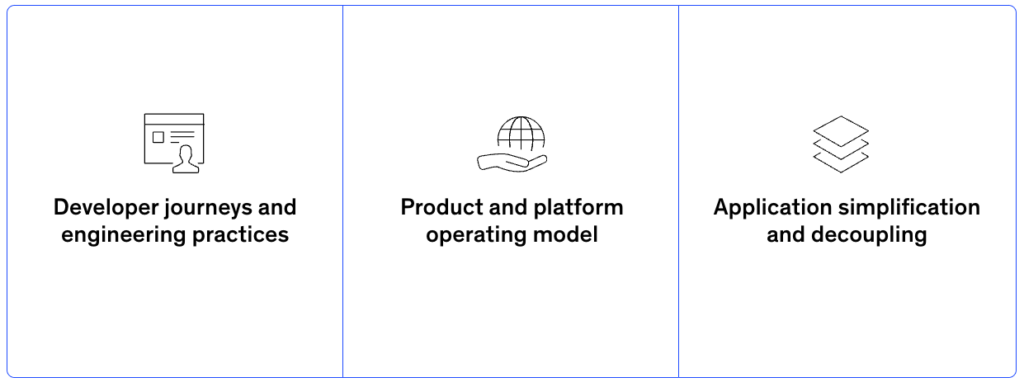New research from McKinsey reveals a game-changing insight: time-to-market isn’t just another KPI—it’s the single biggest driver of IT productivity and enterprise profitability. In today’s digital economy, the ability to rapidly orchestrate change across systems, teams, and processes has become the defining characteristic of market leaders.

“Time-to-market on implementing changes had the strongest correlation with higher profit margins.”
-McKinsey & Company, How high performers optimize IT productivity for revenue growth, December 2024
The numbers are compelling: organizations that excel at rapid delivery achieve 35% higher revenue growth and 10% better profit margins than their peers. But how do they do it? McKinsey’s comprehensive research cuts through the complexity of “IT productivity” to reveal four key insights that separate leaders from laggards:
- Time-to-market emerges as the critical metric for evaluating IT productivity
- Three essential capabilities—cross-functional delivery, internal innovation focus, and cloud-native architecture—drive higher profit margins
- Modern Enterprise Orchestration practices transform how organizations deliver value
- Mature technology organizations unlock 30% additional value through productivity gains
For enterprise leaders, these findings arrive at a crucial moment. As organizations navigate digital transformation, AI adoption, and increasing market pressures, the ability to orchestrate change at scale has never been more vital. This research provides a clear roadmap for transforming IT from a support function into a strategic accelerator of business success.

Want to see how Workato can accelerate your time-to-market?
Schedule a personalized demo with our team to learn more.
Insight #1: Time to Market: The Hidden Multiplier of Enterprise Success
The numbers don’t lie. McKinsey’s latest research reveals that time-to-market isn’t just another metric—it’s the metric that matters most. Companies that excel at rapid IT delivery see 35% higher revenue growth and 10% better profit margins than their peers.
This advantage stems from three critical factors:
- Speed Kills Competition
While slower organizations take a year to implement changes, high performers do it in 2-4 months. That’s not just faster—it’s a different league entirely. In today’s digital economy, speed is the new currency. - Market Dynamics
Modern enterprises run on integrations. Payment systems, customer data, partner APIs—they all need to work seamlessly, and change constantly. While slow-moving IT teams are still planning their next update, agile organizations are already connecting new revenue streams. - Technology Modernization and Adaptability
Fast-moving IT teams don’t get bogged down by legacy systems. They’re constantly refining, updating, and modernizing. This creates a virtuous cycle: better systems enable faster changes, which in turn support more improvements.
Think of it this way: Your competitors aren’t standing still. Every month spent on a change that could take weeks is a month they’re pulling ahead. In a world where digital capabilities often define market leadership, time-to-market isn’t just an IT metric—it’s a business imperative.
Learn more about how iPaaS has emerged as the dominant platform for modern integration.
Insight #2: Three Pillars of High-Performance IT
McKinsey’s research reveals a clear pattern: Organizations that master three specific delivery capabilities consistently outperform their peers. It’s not just about having great technology—it’s about how you deploy it.

The Power Trio:
- Cross-Functional Teams
Top performers build teams where 20-40% are business experts, not just IT specialists. This isn’t about having occasional meetings—it’s about truly integrated teams where SecOps, DevOps, and business domain experts work side by side. - Reduced specialized or outsourced resource dependencies
High performers are more likely to use internal IT resources, using vendors and contractors to develop less than 10 percent of their applications. In contrast, conventional companies rely on vendors and contractors for 40%+ of their application development. - Cloud-Native Architecture
Leading organizations run over 30% of workloads on public cloud—double the industry average of 15-20%. Cloud-native architecture enables rapid experimentation, faster deployments, and the ability to scale innovation across the enterprise
The Impact: Companies mastering these capabilities don’t just perform better—they dominate. The research shows they’re achieving profit margins up to 10% higher than their peers. Enterprise Orchestration platforms enable these three pillars by providing a unified foundation for cross-functional collaboration, internal innovation, and cloud-native development.
The takeaway is clear: These aren’t just best practices—they’re the new table stakes for enterprise IT success.
Insight #3: Orchestration in Action: Three Practices That Unlock IT Performance
This new research cuts through the noise to identify three practices that genuinely move the needle on IT performance. What’s remarkable isn’t just their individual impact—it’s how they work together to transform organizations.

- Streamlined Developer Experience Drives Real Results
Small changes in developer workflows create outsized impacts. One leading bank discovered this when they set out to double their delivery capacity. Their approach was surprisingly straightforward: eliminate manual processes, implement continuous integration/delivery, and leverage AI-powered coding tools. The result? An immediate 10-15% productivity boost. This wasn’t just about efficiency—it was about freeing developers to focus on innovation rather than fighting workflow friction. - Platform-Led Thinking Changes Everything
The most successful organizations have abandoned traditional project-by-project approaches in favor of platform-led transformation. When one financial services company reorganized around service domains, they didn’t just cut expenses by 50%—they fundamentally changed how teams worked. Cross-functional teams gained true autonomy, decisions accelerated, and business outcomes became everyone’s priority. - Breaking Free from Legacy Constraints
Consider the bank that transformed its monolithic systems into cloud-based microservices. The numbers tell the story: from four releases per year to over 10,000, and time-to-market dropped from months to hours. This isn’t just an improvement—it’s a different league of performance entirely.
The Compounding Effect
Together, these practices unlock 30% additional value through productivity gains, with some industries seeing returns up to 34%. But here’s the key insight: successful organizations don’t pocket these savings. They reinvest them, creating a virtuous cycle of continuous improvement and innovation.
For IT leaders, the message is clear: These aren’t just best practices to consider—they’re essential steps toward building a truly high-performing technology organization.
Insight #4: The ROI of IT Maturity
The numbers paint a clear picture: increased technology maturity isn’t just about efficiency—it’s about unlocking massive business value. McKinsey’s research reveals a clear pathway to success.
The Scale of Opportunity
On average, organizations can expect a 24% reduction in total IT spend through increased maturity. For some industries, particularly those in travel, logistics, and infrastructure, the returns are even higher—reaching up to 34%. But this isn’t just about cost savings.
The Multiplier Effect
Smart organizations don’t just bank these gains. They reinvest in further IT advancement, creating a powerful cycle of improvement:
- Initial savings fuel new technology investments
- New capabilities drive additional efficiencies
- Enhanced IT productivity enables faster innovation
- Faster innovation leads to sustained growth
The Bottom Line
While each organization’s journey will be unique, the message is clear: IT maturity isn’t just a technical milestone—it’s a business multiplier. In today’s digital economy, the ability to continuously evolve your technology capabilities isn’t just about staying current—it’s about staying ahead.

Do you know your Total Cost of Operations (TCO)?
Ask our team for a free comprehensive Total Cost of Operations analysis comparing your existing systems to Workato.
The New Equation for Enterprise Success
McKinsey’s research presents a clear mandate for modern enterprises: transform your IT organization from a support function into a strategic accelerator. The impact is transformative:
- 35% higher revenue growth for high performers
- Up to 34% potential returns on IT maturity
- 30% productivity gains through modern practices
But the real story isn’t in these numbers—it’s in what they represent. Leading organizations have discovered that Enterprise Orchestration—the seamless integration of systems, automation of processes, and coordination of data flows—is the catalyst for this transformation.
This is where platforms like Workato become critical. By providing a unified foundation for integration, automation, and API management, Enterprise Orchestration platforms enable organizations to:
- Deploy changes in days instead of months
- Build integrations with minimal specialized resource requirements
- Empower business teams while maintaining IT governance
- Scale automation across the enterprise without technical debt
The path forward is clear: Organizations that embrace Enterprise Orchestration aren’t just checking boxes for integration and automation—they’re building an agile foundation that turns time-to-market into competitive advantage. In a world where speed and adaptability determine market leadership, the ability to orchestrate your enterprise at scale isn’t optional—it’s essential.
The race is on. And it’s the well-orchestrated enterprise that will lead the market.

Ready to accelerate your enterprise transformation?
Schedule a personalized demo with our team to learn more.


